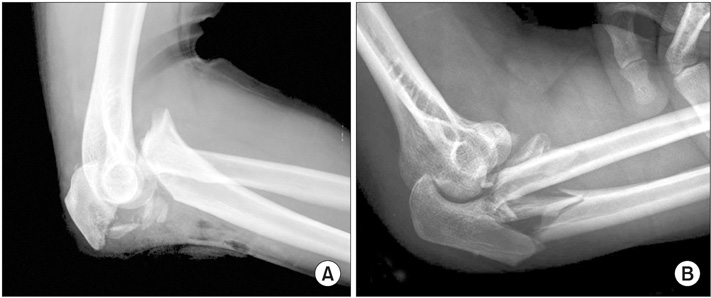J Korean Orthop Assoc.
2017 Dec;52(6):537-542. 10.4055/jkoa.2017.52.6.537.
The Surgical Outcomes of Olecranon Fracture Dislocation of the Elbow
- Affiliations
-
- 1Department of Orthopedic Surgery, Daegu Fatima Hospital, Daegu, Korea. aabga@hanmail.net
- KMID: 2421347
- DOI: http://doi.org/10.4055/jkoa.2017.52.6.537
Abstract
- PURPOSE
The purpose of this study is to evaluate the surgical outcomes of olecranon fracture dislocation in accordance with the direction of the dislocation.
MATERIALS AND METHODS
From December 2006 to February 2016, the surgical outcome in patients who had been followed-up for a minimum of 6 months accompanied with olecranon fracture and elbow instability were reviewed retrospectively. We classified olecranon fracture as either the anterior type or the posterior type. Moreover, we evaluated the clinical results by the Mayo elbow performance scores (MEPS) and checked for any associated injury, age, injury mechanism, and complication.
RESULTS
Fourteen patients had anterior transolecranon fracture dislocation, with an average age of 46 years. The associated lesions were radial head fractures found in 2 patients (14.3%) and coronoid process fracture found in 5 patients (35.7%). Patients with anterior transolecranon fracture showed an average MEPS of 93.2 (70-100). Eight patients with posterior olecranon fracture dislocation had an average age of 66 years (22-87 years). The associated lesions were radial head fractures in 6 patients (75.0%) and coronoid process fracture in 8 patients (100%). Patients with posterior olecranon fracture dislocation showed an average MEPS of 94.4 (80-100). In comparison with the anterior type, posterior type occurred more frequently in elders and showed a greater association with injuries, such as radial head fracture and coronoid process fracture. However, there was no significant difference between the two groups with respect to the clinical outcome.
CONCLUSION
There were differences in frequency of associated injuries and age in accordance with the direction of olecranon fracture dislocation. Moreover, good clinical outcomes were achieved by surgical treatment.
Keyword
Figure
Cited by 1 articles
-
The Result of Locking Compression Plate Olecranon Plate Fixation for Unstable Comminuted Olecranon Fracture
In-Tae Hong, Kyunghun Jung, Yoon Seok Kim, Soo-Hong Han
Arch Hand Microsurg. 2019;24(2):133-141. doi: 10.12790/ahm.2019.24.2.133.
Reference
-
1. Ring D, Jupiter JB. Fracture-dislocation of the elbow. J Orthop Trauma. 1997; 11:545–550.2. Wake H, Hashizume H, Nishida K, Inoue H, Nagayama N. Biomechanical analysis of the mechanism of elbow fracture-dislocations by compression force. J Orthop Sci. 2004; 9:44–50.3. Lindenhovius AL, Brouwer KM, Doornberg JN, Ring DC, Kloen P. Long-term outcome of operatively treated fracture-dislocations of the olecranon. J Orthop Trauma. 2008; 22:325–331.4. Doornberg J, Ring D, Jupiter JB. Effective treatment of fracture-dislocations of the olecranon requires a stable trochlear notch. Clin Orthop Relat Res. 2004; (429):292–300.5. O'Driscoll SW, Jupiter JB, Cohen MS, Ring D, McKee MD. Difficult elbow fractures: pearls and pitfalls. Instr Course Lect. 2003; 52:113–134.6. Biga N, Thomine JM. Trans-olecranal dislocations of the elbow. Rev Chir Orthop Reparatrice Appar Mot. 1974; 60:557–567.7. Ring D, Jupiter JB, Sanders RW, Mast J, Simpson NS. Transolecranon fracture-dislocation of the elbow. J Orthop Trauma. 1997; 11:545–550.8. Ring D, Jupiter JB, Waters PM. Monteggia fractures in children and adults. J Am Acad Orthop Surg. 1998; 6:215–224.9. Bado JL. The Monteggia lesion. Clin Orthop Relat Res. 1967; 50:71–86.10. Reckling FW. Unstable fracture-dislocations of the forearm (Monteggia and Galeazzi lesions). J Bone Joint Surg Am. 1982; 64:857–863.11. Kamali M. Monteggia fracture. Presentation of an unusual case. J Bone Joint Surg Am. 1974; 56:841–843.12. Bruce HE, Harvey JP, Wilson JC Jr. Monteggia fractures. J Bone Joint Surg Am. 1974; 56:1563–1576.13. Jupiter JB, Leibovic SJ, Ribbans W, Wilk RM. The posterior Monteggia lesion. J Orthop Trauma. 1991; 5:395–402.14. Mouhsine E, Akiki A, Castagna A, et al. Transolecranon anterior fracture dislocation. J Shoulder Elbow Surg. 2007; 16:352–357.15. Ring D, Jupiter JB. Fracture-dislocation of the elbow. J Bone Joint Surg Am. 1998; 80:566–580.16. Mortazavi SM, Asadollahi S, Tahririan MA. Functional outcome following treatment of transolecranon fracture-dislocation of the elbow. Injury. 2006; 37:284–288.17. Ikeda M, Fukushima Y, Kobayashi Y, Oka Y. Comminuted fractures of the olecranon. Management by bone graft from the iliac crest and multiple tension-band wiring. J Bone Joint Surg Br. 2001; 83:805–808.18. Ring D, Jupiter JB, Simpson NS. Monteggia fractures in adults. J Bone Joint Surg Am. 1998; 80:1733–1744.19. Bailey CS, MacDermid J, Patterson SD, King GJ. Outcome of plate fixation of olecranon fractures. J Orthop Trauma. 2001; 15:542–548.20. Guerra A, Innao V. Transolecranal dislocations. Ital J Orthop Traumatol. 1982; 8:175–181.
- Full Text Links
- Actions
-
Cited
- CITED
-
- Close
- Share
- Similar articles
-
- Treatment of Transolecranon Fracture-Dislocation of the Elbow
- Reconstruction of the coronoid process using a graft from the olecranon of the same side for chronic posterior dislocation of the elbow
- Surgical Treatment of the Fracture and Dislocation of the Elbow and Early Controlled Mobilization
- Surgical Treatment of Olecranon Fractures
- Clinical Observation of the Olecranon Fracture




